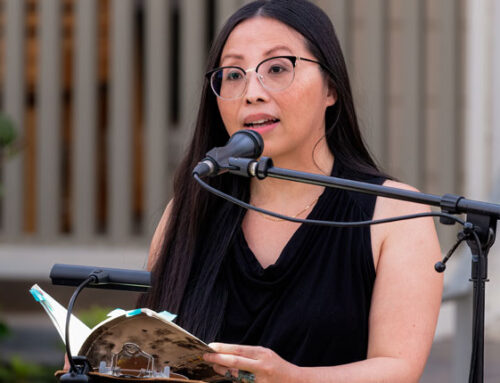Lift-off. That could be the best word to describe recent developments for the PureSense irrigation system management company housed
at the Claude Laval Water and Energy Technology Incubator (WET Incubator) on
the California State University, Fresno campus.
PureSense is one of five new companies using the WET Incubator as a
launching pad for development of water and energy technologies in the San
Joaquin Valley. The big boost for PureSense came in late March, when company
leaders announced a capital commitment of $4.5 million by local and regional
investors to help the business grow.
The PureSense irrigation management system uses information obtained
from the company’s free-standing, solar-powered monitoring stations that
acquire data on soil moisture, weather conditions and plant vitals. On-board
station computers transmit the data over cell networks to secure servers
linked to the Internet.
Through a combination of software and firmware, the data, which is
transmitted every 15 minutes, is converted into a user-friendly interface
that a grower can use to monitor soil moisture and plant growth.
The technology used in the interface emerged from improved
communications systems developed by the federal government at NASA Ames
following the 9/11 terrorist attacks in New York City. PureSense obtained
user rights through a special licensing agreement with NASA, said Matt
Angell, the company’s head of market and sales development.
Key to the Pure Sense system’s power is the ability of the
monitoring station to capture and integrate data on climate conditions,
plant health and sub-surface soil moisture conditions, Angell said. Analysis
is presented in a web-based interface that gives growers real-time analyzed
snapshots on crop reactions to changing environmental conditions including
temperature, humidity, wind speed, solar radiation and perhaps most
importantly, soil moisture.
“We’re used to decision-making based on what we see above the
ground,” Angell said. “We want to help growers also understand what’s going
on under the ground. Until we were able to measure soil moisture, we weren’t
able to do that.”
In setting up the system, one or more five-foot-long soil moisture
sensors are strategically placed in the field or fields to be monitored.
Placement represents the dominant soil type of the area. The patented
sensors are equipped not only with moisture measuring devices every 12
inches, but also with an on-board mini-computer that records and transmits
the data every 15 minutes.
“With this type of sensor, at each level you can see the soil
moisture. You have the ability to make predictions of when and where water
will be needed based on where the water went,” Angell said.
The Web-based interface features graphic images of actual
conditions, formatted to make it easy for a grower to quickly interpret the
information and make decisions. Recognizable images like a fuel gauge
indicate subsurface water supply, plant consumption, and requirements for
targeted crop yield and quality.
PureSense is currently teaming with scientists from Fresno State’s
Viticulture and Enology Research Center (VERC) to help manage an experiment
evaluating delayed wine grape harvest with the vines under deficit
irrigation treatments. The partnership developed through a meeting with
PureSense representatives and VERC director Robert Wample last year.
According to Wample, the collaboration is a win-win for all involved.
“This association with PureSense will expose us and our students to
this new technology,” Wample said, “and it will help them in building their
model for decision-making.”
According to Angell, PureSense is built to serve growers by
providing them with the most up-to-date information possible on soil and
climate conditions.
“It lets you harness the power of real-time data to meet your
production management goals, and it eliminates the risk of not knowing or
taking action at the right time in the right place,” he said.
The investment funding by the PureSense irrigation system management
company is proof of how a good business idea can turn into capital. It’s
also the first of what leaders of the Water and Energy Technology Incubator
hope will be many more success stories of businesses launched at the
facility.
“The basic idea behind the ICWT/WET partnership is to assist
start-up companies during the critical ‘incubation’ phase,” said David
Zoldoske, interim director of the ICWT and also director of Fresno State’s
Center for Irrigation Technology (CIT).
“The first 12 to 24 months really are critical to the success of these
companies. Clearly, being able to attract $4.5 million in venture capital
shows the strength of the product and management team.”
One of the key goals of the ICWT is promote water use efficiency,
and to bolster economic development in the San Joaquin Valley. The growth
and success of PureSense would be a great example of this effort, Zoldoske
said.
“Anytime we can create an economic base locally it will provide
multiple benefits to the region. Synergy develops among companies, with
potential allied or spin-off efforts. Additionally, these companies create
technical and marketing jobs locally, which provides great opportunities for
our students to take advantage of local career opportunities,” Zoldoske
said.
Another advantage of the location of the WET Incubator is its proximity to
Fresno State agriculture. New technologies can be applied directly to the
Fresno State Farm, where they will serve to assist research, educate
students, and help to improve water management program on the Farm.
“The PureSense product not only has the potential to improve water
use efficiency in California agriculture, but the world,” Zoldoske said.
For more information on PureSense technology, contact Angell at
mangell@puresense.com.
(Copy Steve Olson of the California Agricultural Technology Institute.)




